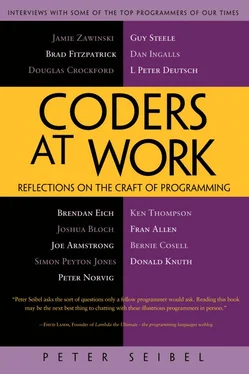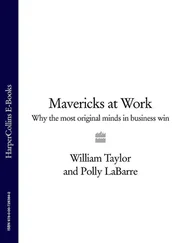Peter Seibel - Coders at Work - Reflections on the craft of programming
Здесь есть возможность читать онлайн «Peter Seibel - Coders at Work - Reflections on the craft of programming» весь текст электронной книги совершенно бесплатно (целиком полную версию без сокращений). В некоторых случаях можно слушать аудио, скачать через торрент в формате fb2 и присутствует краткое содержание. Жанр: Программирование, на английском языке. Описание произведения, (предисловие) а так же отзывы посетителей доступны на портале библиотеки ЛибКат.
- Название:Coders at Work: Reflections on the craft of programming
- Автор:
- Жанр:
- Год:неизвестен
- ISBN:нет данных
- Рейтинг книги:3 / 5. Голосов: 1
-
Избранное:Добавить в избранное
- Отзывы:
-
Ваша оценка:
- 60
- 1
- 2
- 3
- 4
- 5
Coders at Work: Reflections on the craft of programming: краткое содержание, описание и аннотация
Предлагаем к чтению аннотацию, описание, краткое содержание или предисловие (зависит от того, что написал сам автор книги «Coders at Work: Reflections on the craft of programming»). Если вы не нашли необходимую информацию о книге — напишите в комментариях, мы постараемся отыскать её.
Coders at Work
Founders at Work
Coders at Work: Reflections on the craft of programming — читать онлайн бесплатно полную книгу (весь текст) целиком
Ниже представлен текст книги, разбитый по страницам. Система сохранения места последней прочитанной страницы, позволяет с удобством читать онлайн бесплатно книгу «Coders at Work: Reflections on the craft of programming», без необходимости каждый раз заново искать на чём Вы остановились. Поставьте закладку, и сможете в любой момент перейти на страницу, на которой закончили чтение.
Интервал:
Закладка:
One other thing I think schools can do is the stuff that’s in Knuth. I’m surrounded by people who think linked lists are magic. They don’t know anything about the 83 different kinds of trees and why some are better than others. They don’t understand about garbage collection. They don’t understand about structures and things.
Then the next volume: sorting and searching. If the programming language didn’t have a sort function, they wouldn’t have a clue about different types of sorting, or how to search for things, when you should build indexes, what it means that the database we’re using stores things in a B-tree. I think a good course would give them background not in, how do you write a linked list in C—that’s a craftsman thing—but what do linked lists do in an abstract sense?
Seibel:Perhaps the most famous project you worked on was the beginning of the ARPANET, when you, Will Crowther, and Dave Walden wrote the software for the original ARPANET IMPs. How did that come about?
Cosell:In Frank Heart’s group, our division, Frank viewed all of his programmer guys as this basic stable. He picked and chose how to move people from project to project. When my projects ran out, Frank would figure out what I should work on next. As opposed to the real consulting guys who would start flying to Washington and writing proposals; I was spared having to do that. Somehow, Frank had decided that I was to be the third guy on the IMP project.
I was working on another project in the fall of ’68 when Dave and Willy and those guys had started. I think the contract had been awarded but wasn’t going to start until January. When I joined the project, not much was done. I think they had scraped out some of the code, but nothing was really cycling yet. When I came on board and Dave and Willy had started blocking out how the system was going to be organized and had taken hunks that they were starting to write. I just fit in and claimed a piece or two for myself. We all had different skills but we were all going to know how every line of code worked for the thing because it wasn’t that big a program. Complicated, but not that big.
And I know they couldn’t have gotten very much done when I joined because they were still doing offline assemblies, which involved taking a paper tape into the Honeywell room where there was a 516 and running paper tapes through, making an assembly listing by having it punch an entire box of paper tape, which they would then have to carry to another machine because there was no line printer on the Honeywell machine to make an assembly listing. It was really pretty cumbersome doing the software management for that. One of the first concrete things I did on the project was I wrote a cross assembler for our PDP-1.
Then on the PDP-1 we could edit the files, assemble the files, make assembly listings of the files, run TECO macros over things. The only thing that got punched out was the comparatively small paper tape of the binary executable program, which would then go into the Honeywell machine.
Seibel:Was that the biggest challenge of writing the IMP software: making it go fast?
Cosell:Oh, that’s interesting. Well, let’s see. We didn’t think very much about how big it was because the idea was that the system was going to have to have a lot of space for buffering. And the code wasn’t going to be that big. And if the code was, say, ten percent larger than it could be if you squeezed it down, that would just mean that there would be a few fewer buffers. So we weren’t quite so much worried about counting how many instructions everything took.
Seibel:In terms of how much space it would take.
Cosell:Right. How much space. But we were concerned with speed, whether we were going to keep up with the bandwidth. And how do you organize a system so that it degrades gracefully and, in particular, degrades in a way that it can dig itself out of a hole as opposed to just collapsing and dying?
The second thing was just making the system work. There was a lot of untried, untested stuff. Were the protocols going to work? Will had come up with some ideas for the routing algorithm—was that going to work? There were still a lot of underlying questions. A question about congestion control. Did we know for sure that if everybody in the world sent packets to one poor guy that we would actually refuse the packets in the right order and dig himself out?
Seibel:So that was basically because nobody had ever tried to solve this problem before.
Cosell:Exactly right. It was a research project at that point—a lot of theory. A lot of people had written dissertations. A lot of people thought they knew what was going on. At that point, the rubber had to meet the road. We had to actually see whether the queuing theory was going to work, whether the routing algorithm could oscillate.
The third big challenge was simply how do you debug the thing. All of a sudden, you can’t talk to Cincinnati, Ohio. What went wrong? How do you figure it out? You call Cincinnati, Ohio, and you get a sleepy night watchman at 3:00 in the morning walking up to this little blinking box in the corner. What does he look at? What do you do? And even if you get the system back up, what went wrong? How do you fix it? Remember, I was a big things-don’t-crash, things-are-going to-keep-working guy.
I know that one of the things that impressed Will was there was some bug that they could not find and I found it. It turns out it was a bug in the handling of some protocol for the modems and it was sending the wrong packet at the wrong time. I put together a series of patches so that I could put a marker in a packet and when it saw that particular packet, it installed a patch on the system that looked for this other thing happening and as soon as it saw it, it stopped the system. Then once it stopped the system, we could use debuggers to figure out what was going on. Once I had done that, it took about two minutes to find the bug because the offending packet was still in memory; it hadn’t been written over.
I don’t remember the exact problem, but it was one of these problems that was not fatal. There was a bad pointer corrupting memory and the corruption wasn’t causing any trouble, but thousands and thousands of machine cycles later, the program crashed because some data structure was corrupt. But it turns out the data structure was used all the time, so we couldn’t put in code that says, “Stop when it changes.” So I thought about it for a while and eventually I put in this two- or three-stage patch that when this first thing happened, it enabled another patch that went through a different part of the code. When that happened, it enabled another patch to put in another thing. And then when it noticed something bad happening, it froze the system. I managed to figure how to delay it until the right time by doing a dynamic patching hack where one path through the code was patched dynamically to another piece of the code. And I was lucky because I guessed the right thing and we immediately found the problem.
Seibel:What enables that kind of intuition?
Cosell:On the systems I’m very good with like that, like the IMP system when I had it all in my head, or the PDP-1 time-sharing system, even though the system is a multiprogramming, multilayered, interrupt-driven system, I have all the dynamics of the system in my head. I know what order things are supposed to happen. I know somehow what’s not supposed to happen, when things are supposed to not be happening. That lets me build up a model for, “How could this thing possibly have happened?”
And at least some of those were two-machine problems, which also required some odd creativity to find. That is, the trouble is something goes wrong on my machine and the evidence of it shows up on yours. I can’t stop—my machine has already processed 6,000 more packets by the time yours hits the trap that says, “I got a bogus packet.” So now what do you do? We’d work through, the three of us, finding ways to track those things down and fix them and basically make the system pretty solid.
Читать дальшеИнтервал:
Закладка:
Похожие книги на «Coders at Work: Reflections on the craft of programming»
Представляем Вашему вниманию похожие книги на «Coders at Work: Reflections on the craft of programming» списком для выбора. Мы отобрали схожую по названию и смыслу литературу в надежде предоставить читателям больше вариантов отыскать новые, интересные, ещё непрочитанные произведения.
Обсуждение, отзывы о книге «Coders at Work: Reflections on the craft of programming» и просто собственные мнения читателей. Оставьте ваши комментарии, напишите, что Вы думаете о произведении, его смысле или главных героях. Укажите что конкретно понравилось, а что нет, и почему Вы так считаете.












